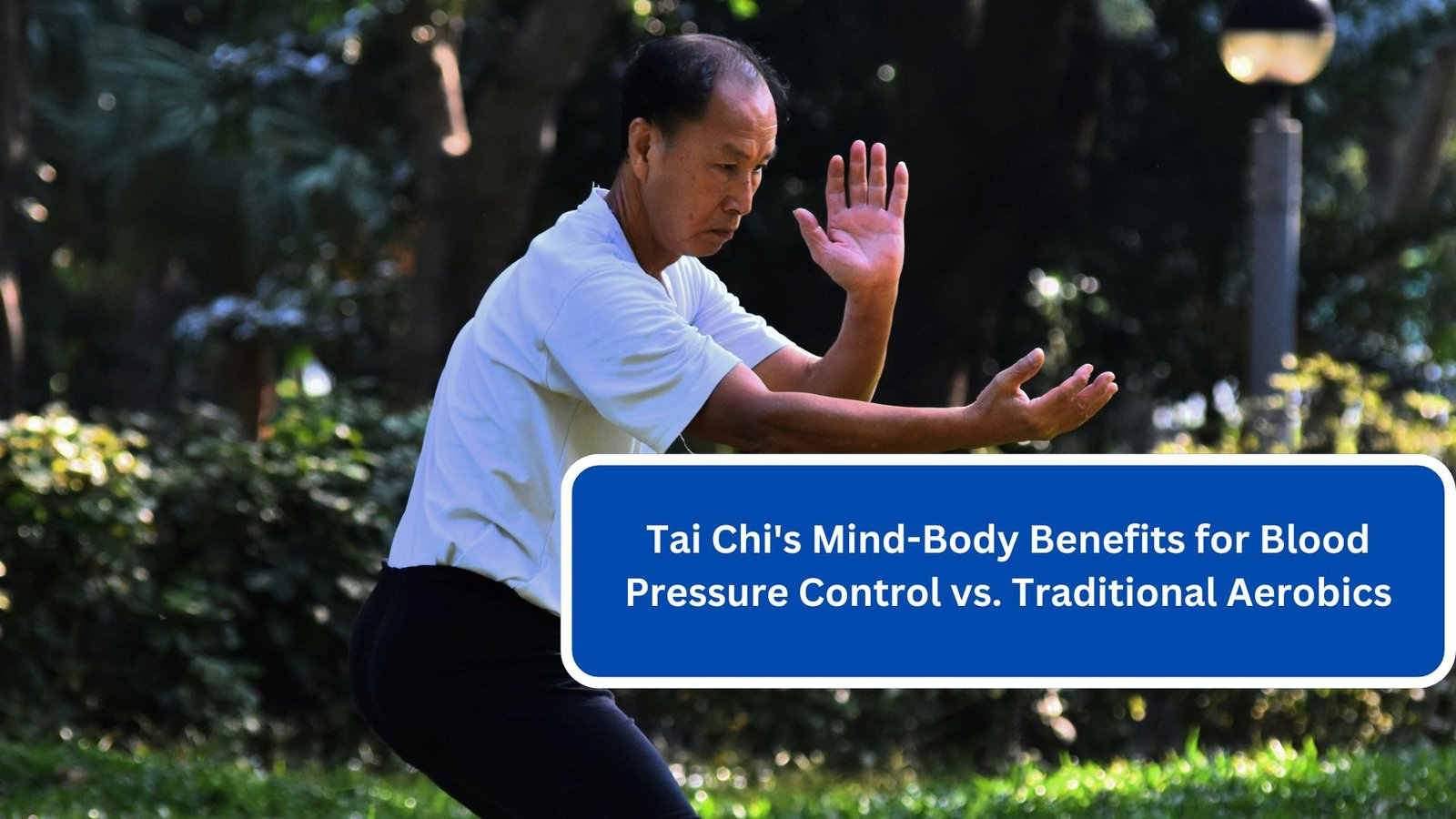High blood pressure, or hypertension, is a serious and widespread health condition affecting millions of people worldwide. Often referred to as the “silent killer” due to its typically asymptomatic nature, untreated hypertension can lead to severe health problems such as heart disease, stroke, and kidney failure. Managing blood pressure through lifestyle changes, including exercise, is one of the most effective ways to lower the risk of these complications.
While aerobic exercise has long been considered the standard approach for cardiovascular health and blood pressure management, an ancient Chinese practice—Tai Chi—is emerging as a powerful alternative, offering unique mind-body benefits that extend beyond traditional aerobic workouts. This article will delve into the differences between Tai Chi and aerobic exercise when it comes to blood pressure control, focusing on how Tai Chi’s integrated approach to physical and mental well-being can offer significant advantages over conventional methods.
Understanding Blood Pressure and Its Impact
Before comparing the effects of Tai Chi and aerobic exercise on blood pressure, it’s important to understand what blood pressure is and why controlling it is vital for overall health.
Blood pressure is the force exerted by circulating blood against the walls of the arteries. It is measured in two numbers: systolic pressure (the top number), which represents the pressure in the arteries when the heart beats, and diastolic pressure (the bottom number), which indicates the pressure in the arteries when the heart is at rest between beats. A healthy blood pressure is generally considered to be around 120/80 mmHg. Hypertension occurs when blood pressure consistently stays at 130/80 mmHg or higher.
There are many factors that can contribute to high blood pressure, including genetics, poor diet, lack of physical activity, smoking, and stress. While medication is often prescribed to manage hypertension, lifestyle interventions—such as adopting a healthy diet and engaging in regular physical activity—are critical components of long-term blood pressure control.
Aerobic Exercise and Blood Pressure
Aerobic exercise has long been touted as a highly effective method for controlling blood pressure. Activities such as running, swimming, cycling, and brisk walking are characterized by sustained, rhythmic movements that elevate the heart rate, improve cardiovascular function, and increase oxygen consumption. These exercises strengthen the heart, allowing it to pump blood more efficiently, and improve the elasticity of blood vessels, which can lower blood pressure over time.
Limitations of Aerobic Exercise for Hypertension
While aerobic exercise is undeniably beneficial for heart health and blood pressure management, it may not be the best option for everyone. Traditional aerobic workouts often focus solely on the physical aspects of fitness—such as endurance, strength, and cardiovascular function—without addressing the mental or emotional factors that can contribute to high blood pressure. For individuals whose hypertension is linked to chronic stress or anxiety, aerobic exercise alone may not effectively address the underlying causes of their elevated blood pressure.
Moreover, high-intensity aerobic exercise can temporarily elevate blood pressure during the workout, which might be a concern for some individuals with hypertension. The physical demands of aerobic exercise can also be challenging for older adults or people with limited mobility, making it difficult for them to engage in these activities regularly.
This is where Tai Chi’s mind-body approach offers unique advantages. Tai Chi addresses both the physical and psychological aspects of health, making it an effective, low-impact alternative for controlling blood pressure.
Tai Chi: A Holistic Approach to Blood Pressure Control
Tai Chi is a centuries-old Chinese martial art that has evolved into a mind-body practice emphasizing slow, flowing movements, deep breathing, and mindfulness. It is often described as “meditation in motion” because of its focus on mental clarity and relaxation, in addition to physical movement. Tai Chi’s holistic nature makes it particularly well-suited for managing hypertension, as it targets not only cardiovascular health but also stress reduction and mental well-being.
How Tai Chi Affects Blood Pressure
Tai Chi’s effectiveness in lowering blood pressure can be attributed to several key factors that differentiate it from traditional aerobic exercise:
1. Activation of the Parasympathetic Nervous System
One of the primary benefits of Tai Chi is its ability to activate the parasympathetic nervous system, which is responsible for promoting relaxation and reducing stress. Unlike the sympathetic nervous system, which triggers the body’s “fight or flight” response—resulting in an increase in heart rate, blood pressure, and the release of stress hormones—the parasympathetic nervous system calms the body down. Tai Chi’s slow movements and deep breathing exercises help shift the body from a state of stress (sympathetic dominance) to a state of relaxation (parasympathetic dominance).
By promoting this relaxation response, Tai Chi reduces the production of stress hormones such as cortisol and adrenaline, which are known to contribute to high blood pressure. Additionally, the activation of the parasympathetic nervous system leads to a slower heart rate and improved blood circulation, both of which are crucial for lowering blood pressure.
In contrast, traditional aerobic exercise—especially high-intensity workouts—can stimulate the sympathetic nervous system, which may temporarily raise blood pressure during physical exertion. While the long-term cardiovascular benefits of aerobic exercise are well-documented, this short-term increase in blood pressure might not be ideal for individuals with hypertension.
2. Stress Reduction and Mindfulness
Stress is a major contributor to high blood pressure, and Tai Chi’s emphasis on mindfulness and relaxation provides a powerful tool for managing stress-related hypertension. During Tai Chi practice, participants are encouraged to focus on their breath, movement, and the present moment, which fosters a state of mental calmness and clarity. This mindful awareness reduces the mind’s tendency to ruminate on stressful thoughts and anxieties, breaking the cycle of stress that can lead to elevated blood pressure.
Mindfulness practices like Tai Chi have been shown to reduce stress-related hormones and decrease overall stress levels, which directly impacts blood pressure regulation. A study published in the Journal of Hypertension found that mindfulness-based interventions, including Tai Chi, significantly reduced both systolic and diastolic blood pressure in patients with hypertension.
In contrast, traditional aerobic exercise may not offer the same level of mental relaxation and stress reduction. While aerobic workouts can certainly release endorphins and improve mood, they don’t typically incorporate the mindful, meditative elements that are central to Tai Chi. This makes Tai Chi particularly beneficial for individuals whose high blood pressure is exacerbated by chronic stress or anxiety.
3. Low-Impact Movements for Improved Circulation
Tai Chi’s slow, controlled movements improve blood circulation without placing undue stress on the heart or joints. This makes Tai Chi an ideal exercise for individuals with hypertension, especially those who may not be able to engage in high-intensity aerobic activities due to age, injury, or limited mobility.
Tai Chi’s low-impact nature also means that it can be practiced safely by individuals of all fitness levels. Unlike aerobic exercises that may involve rapid movements or sustained physical exertion, Tai Chi is gentle on the body and can be modified to suit the needs of the practitioner. This accessibility makes it easier for individuals with hypertension to adopt and maintain a consistent exercise routine, which is essential for long-term blood pressure control.
4. Improved Breathing and Oxygenation
Deep, controlled breathing is a central component of Tai Chi practice, and it plays a significant role in lowering blood pressure. Known as diaphragmatic breathing or abdominal breathing, this type of breathing encourages full lung expansion, which increases oxygen intake and promotes relaxation.
When practiced regularly, deep breathing can lower heart rate and reduce blood pressure by improving the body’s oxygenation and calming the nervous system. Tai Chi practitioners often synchronize their breathing with their movements, which enhances the meditative aspect of the practice and further reduces stress.
Aerobic exercise, while beneficial for improving lung capacity and oxygen consumption, often involves more rapid breathing due to the intensity of the workout. This can sometimes lead to shallow breathing, especially in individuals who are not accustomed to sustained physical exertion. In contrast, Tai Chi’s focus on slow, deep breathing provides a more consistent method for enhancing oxygenation and promoting relaxation.
5. Long-Term Cardiovascular Benefits
While Tai Chi is often viewed as a low-intensity exercise, its long-term cardiovascular benefits are comparable to, and in some cases, greater than those of traditional aerobic exercise. Studies have shown that Tai Chi can lead to significant reductions in both systolic and diastolic blood pressure over time.
A meta-analysis published in The American Journal of Cardiology found that individuals who practiced Tai Chi experienced a significant reduction in blood pressure, particularly among older adults. The study concluded that Tai Chi’s unique combination of physical movement, deep breathing, and mindfulness made it an effective tool for managing hypertension, especially when compared to traditional aerobic exercise alone.
Moreover, Tai Chi’s gentle movements improve flexibility, balance, and muscle strength, all of which contribute to overall cardiovascular health. By promoting better circulation and reducing the workload on the heart, Tai Chi supports long-term heart health and helps prevent the development of other cardiovascular conditions associated with hypertension.
6. Emotional and Mental Health Benefits
In addition to its physical benefits, Tai Chi offers significant emotional and mental health benefits that can further contribute to blood pressure control. The practice’s emphasis on mindfulness and relaxation can reduce symptoms of anxiety and depression, both of which are linked to elevated blood pressure.
Research has shown that individuals who practice Tai Chi regularly experience improvements in mood and emotional well-being, which can lower the risk of stress-induced hypertension. Unlike aerobic exercise, which may focus primarily on physical fitness, Tai Chi addresses the mind-body connection, helping individuals cultivate a sense of inner peace and emotional resilience.
Tai Chi vs. Aerobic Exercise: Which is Better for Blood Pressure Control?
While both Tai Chi and aerobic exercise have their respective benefits for cardiovascular health, Tai Chi offers unique advantages when it comes to managing blood pressure, particularly for individuals with stress-related hypertension or those who may struggle with high-intensity workouts. Tai Chi’s ability to activate the parasympathetic nervous system, reduce stress, and promote mental well-being makes it a powerful tool for long-term blood pressure control.
That said, it’s important to note that aerobic exercise is still an excellent option for individuals looking to improve cardiovascular fitness, lose weight, and strengthen the heart. For optimal blood pressure control, a combination of both Tai Chi and aerobic exercise may provide the most comprehensive benefits. Tai Chi’s relaxation techniques can complement the cardiovascular benefits of aerobic workouts, offering a balanced approach to physical and mental well-being.
Conclusion
Tai Chi’s mind-body approach to exercise offers a powerful alternative to traditional aerobic workouts for managing blood pressure. By promoting relaxation, reducing stress, and improving circulation through low-impact movements and deep breathing, Tai Chi addresses both the physical and psychological factors that contribute to hypertension. While aerobic exercise remains a valuable tool for cardiovascular health, Tai Chi’s unique blend of movement, mindfulness, and meditation provides significant advantages for individuals seeking a holistic approach to blood pressure control.
For those looking to lower their blood pressure and improve overall health, incorporating Tai Chi into their routine may offer lasting benefits that go beyond traditional exercise methods. As more research continues to highlight Tai Chi’s effectiveness in managing hypertension, this ancient practice is gaining recognition as a valuable addition to modern healthcare strategies for long-term cardiovascular health.

